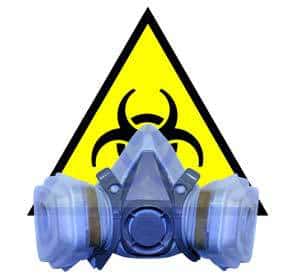Question: My question involves respirators for spraying pesticides in the garden. My husband handles all the “pest control” on our yard.
He even tries at times to make his own natural homemade pesticides to use because he thinks they are safer and cheaper. However, should he wear pesticide masks and googles when applying chemicals at home? Heather, Hamilton, Canada

Answer: Excellent question on the use of spray masks and pesticides around the home and in the garden! Unfortunately, many pesticide applicators, homeowners and commercial alike do not correctly use pesticide respirators, have them fitted properly and others don’t use them at all.
Read the Pesticide Label
Pesticide labels are the law, however, when making a homemade natural pesticide obviously there is no label to go by or you be using an “environmentally friendly pesticide” and assume a garden mask is not needed.
Even if the label on the pesticide does not mention or require a respirator, I would ALWAYS recommend wearing a properly fitted pesticide mask.
A spray mask should always be used when applying any potentially harmful material especially in an enclosed area. The reason is simple and I even follow this practice when using natural organic neem insecticide oil on plants.
I would also wear other Personal Protective Equipment (PPE) wear like: Nitrile, rubber or chemical-resistant gloves, long pants, long-sleeved shirt, goggles, safety glasses, boots and face shield.
The lungs and all the other parts of the body, which make up the breathing and respiratory system, are highly efficient. The respiratory system can absorb into our body much more pesticides from the small floating particles than the skin.
Breathing in particles greatly increases the effect of pesticides on humans. That is why the label on the pesticide often carries a precautionary statement like “do not breath vapor or spray mist” or “harmful or fatal if inhaled.” Always have that face mask added in your kit before working around these harmful chemicals.
Types Of Respirators – Air Purifying and Air Supplying
Respirators come in basically two types:
- Air Purifying – This type of respirator protects the applicator by removing organic vapors and contaminants from the air.
- Air Supplying – This type of respirator supplies air from an independent air source. Sort of like those doing HAZMAT work.

In my thirty-plus years of nursery work I’ve never had to go the air-supply breathing apparatus route and for most people the air-purifying respirator should deliver adequate protection.
Air Purifying Respirators – Three Basic Styles
The primary function of air-purifying respirators is to filter out and remove contaminants like dusts, mists, and particles; however, they can in some cases also remove gases and vapors.
- Style #1 – This type of “pesticide mask” is shaped to cover the nose and mouth and filters out dusts, mists, and particles. Remember pesticides do not come in only a liquid form, which is sprayed. Dust types are also used and can produce fine particles that float in the air.
- Style #2 – The second style is a facial mask, which comes with one or more cartridges. Some masks are one-piece units and the cartridges permanently attached to the face piece. When finished using entire unit just throw it out.
- Style #3 – The third style is a mask utilizing canisters that contain air-purifying materials. We usually call these “gas masks” for short!
How Respirators Work
Air-purifying type respirators pull or draw air through the filters in one of two ways. The most common is lung power! The one wearing the mask draws air through the filter material with each and every breath. Most mist/dust masks, cartridge and canister respirators take advantage of this type of manual lung power.
Picking the Proper Equipment
When selecting masks and cartridges for dust/mist-filtering make sure they are approved by (NIOSH) National Institute for Occupational Safety and Health and by (MSHA) the Mine Safety and Health Administration. Other filters may not be acceptable or as protective.
Always use a mist or dust face mask held in place with two straps. One-strap styles are not approved by NIOSH and MSHA because they do not keep the respirator adequately sealed against the face. Make sure you do a respirator fit test to confirm the mask seals well.
Related: Best Backpack Sprayer – A Guide to Selection and Use
In general I would always recommend using and wearing a respirator when applying any insecticide, pesticide or other chemicals that could be harmful. That’s why the Worker Protection Standards< were put in place and the guidelines are useful for homeowners to follow as well.
Using respirators correctly is essential to protect the applicators respiratory system from harmful chemicals.
The label is the law and although applicators should always follow the pesticide label and instructions of the respirator manufacturer like 3M, Kimberly-Clark and Kleenguard using some common sense never hurts either. When in doubt – safety first!